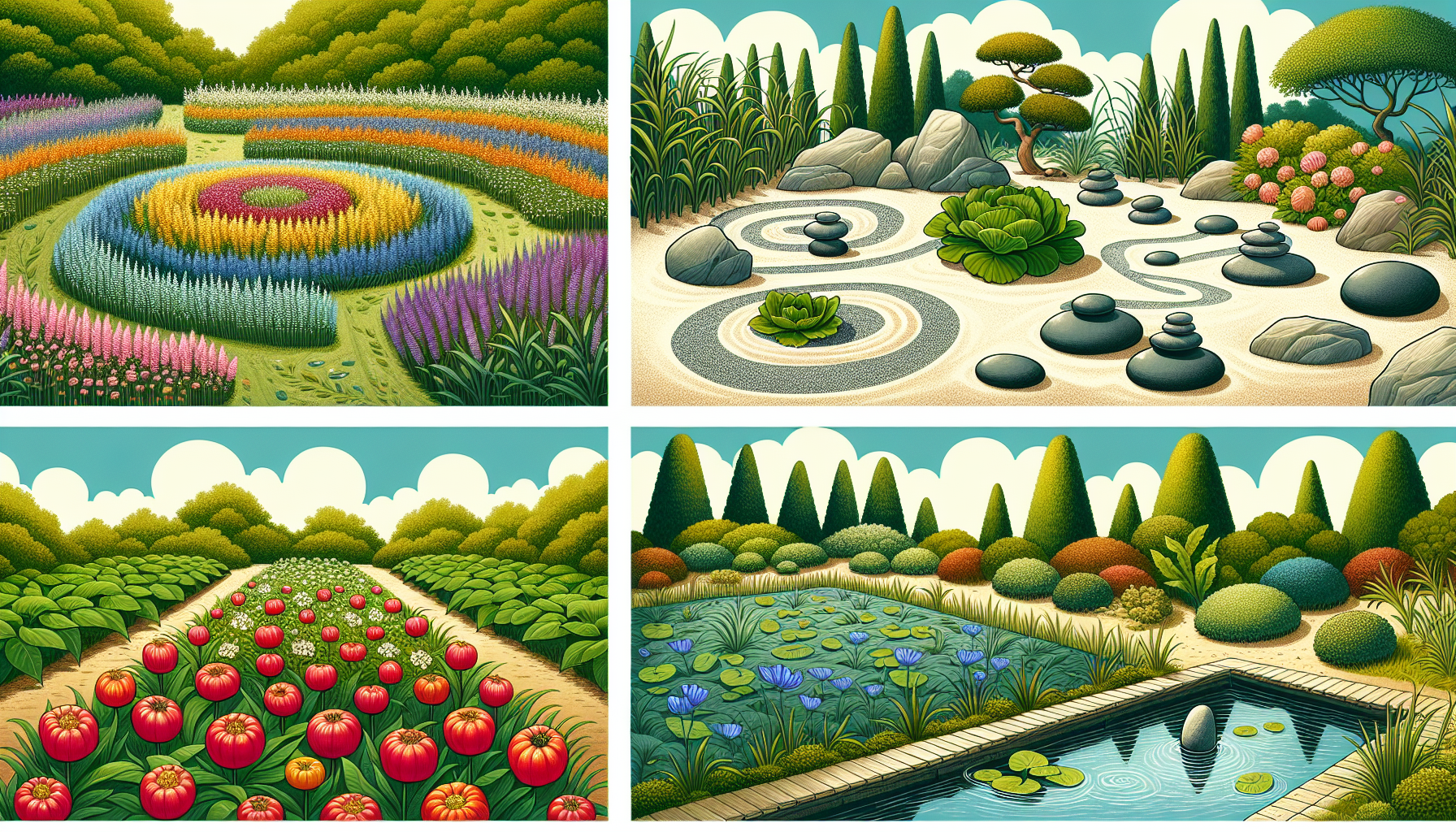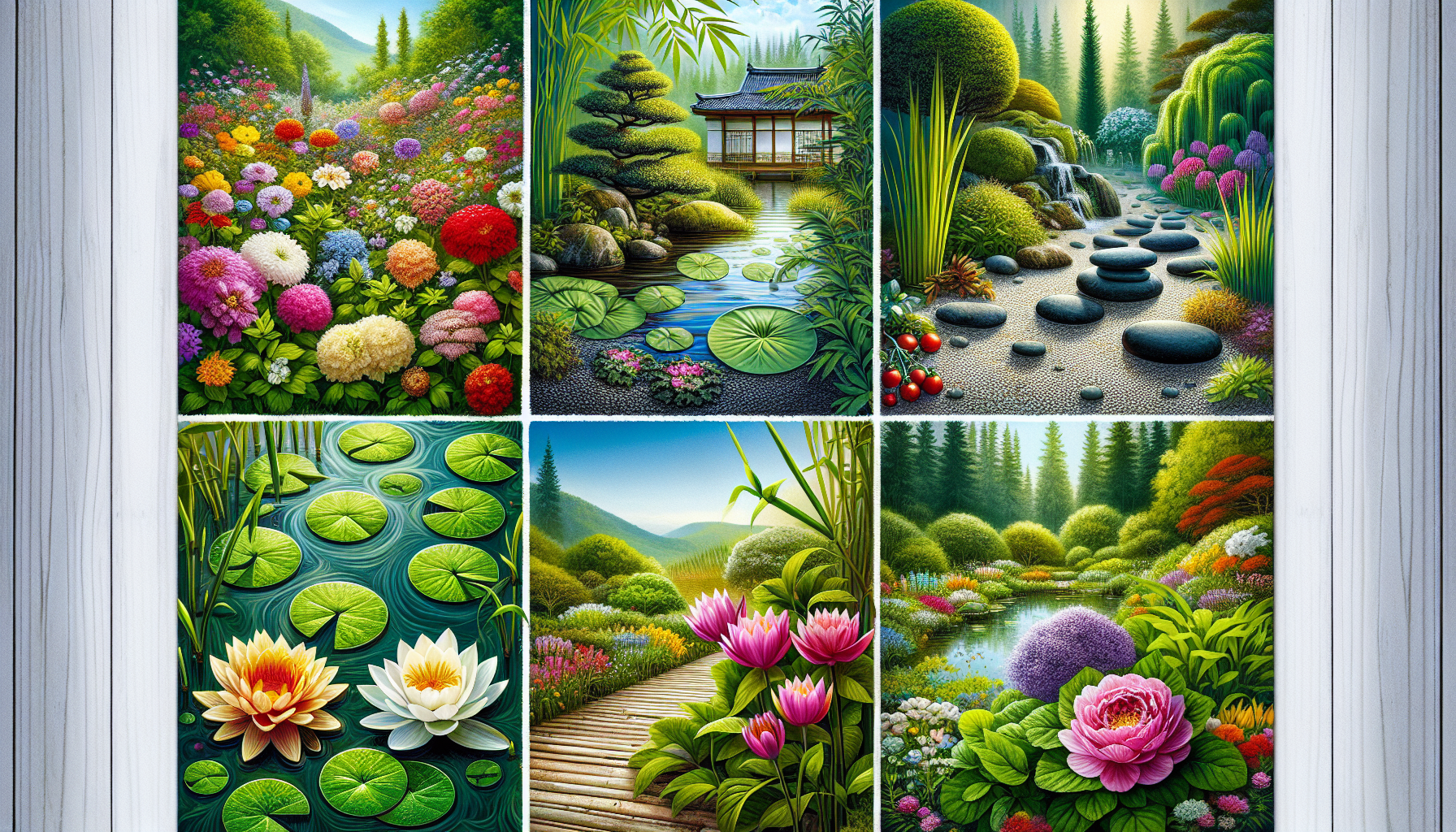Are you curious about the different types of gardens? Look no further because this article will provide you with a concise overview of the four main types. Whether you have a green thumb or are just starting your gardening journey, understanding these garden types will help you create the perfect outdoor oasis. From formal gardens that exude elegance to wild and natural landscapes that embrace the beauty of nature, there is a garden style that suits every taste and preference. So, let’s explore the enchanting world of gardens together!

Flower Garden
A flower garden is a beautiful and vibrant addition to any outdoor space. Its purpose is to provide a space filled with a variety of flowers that can be enjoyed for their aesthetic appeal, fragrance, and the positive impact they have on the surrounding environment. Flower gardens can range in size from small, manageable beds to large, sprawling landscapes.
Types of Flowers
There are countless types of flowers that you can choose for your garden, each with its own unique beauty and characteristics. Some popular choices include roses, daisies, lilies, tulips, sunflowers, and orchids. When selecting flowers for your garden, consider factors such as their color, bloom time, and maintenance requirements. This will help ensure that you have a diverse and visually stunning display throughout the year.
Design and Layout
When designing your flower garden, it’s important to consider the overall layout and arrangement of the flowers. You can create a cohesive and eye-catching design by using a combination of color, height, and texture. For example, you can plant taller flowers towards the back of the garden and shorter ones towards the front to create depth and visual interest. Additionally, grouping flowers of the same color together can create a striking focal point. Ensure that you provide adequate space for each plant to grow and thrive, and consider incorporating pathways or stepping stones for easy access and enjoyment of your garden.
Vegetable Garden
A vegetable garden is not only a practical addition to your outdoor space but also a rewarding and fulfilling hobby. The purpose of a vegetable garden is to grow edible plants that can be enjoyed as part of a healthy diet. Having your own vegetable garden allows you to have access to fresh, organic produce and can contribute to a reduction in your overall food costs.
Types of Vegetables
There is a wide variety of vegetables that you can grow in your garden, ranging from leafy greens like lettuce and spinach to root vegetables like carrots and potatoes. Other popular choices include tomatoes, peppers, cucumbers, beans, and herbs like basil and parsley. When selecting vegetables for your garden, consider your climate and the amount of available sunlight, as these factors can impact their growth and productivity. Additionally, be mindful of the specific planting and care requirements of each vegetable to ensure a successful harvest.
Design and Layout
When planning the design and layout of your vegetable garden, it’s important to consider factors such as sunlight, soil quality, and the specific needs of each vegetable. Ensure that your garden receives ample sunlight throughout the day, as most vegetables require at least six hours of direct sunlight to thrive. Consider grouping vegetables with similar sunlight and water requirements together to optimize their growth. Additionally, ensure that your soil is well-draining and rich in organic matter to provide a healthy environment for your plants. You can also incorporate raised garden beds or containers to maximize space and make caring for your garden more convenient.

Herb Garden
An herb garden is a practical and aromatic addition to any outdoor space. Its purpose is to provide a dedicated area where a variety of herbs can be grown for culinary, medicinal, and decorative purposes. Having your own herb garden allows you to have a readily available and fresh supply of herbs to enhance your cooking, create natural remedies, and add fragrance to your surroundings.
Types of Herbs
There are numerous herbs that you can choose to grow in your garden, each with its own unique flavors and uses. Some popular choices include basil, rosemary, thyme, mint, cilantro, and lavender. When selecting herbs for your garden, consider your own personal preferences, as well as the specific growing requirements of each herb. Some herbs thrive in full sun, while others prefer partial shade. It’s also important to consider the climate and growing season in your region to ensure successful herb cultivation.
Design and Layout
When designing your herb garden, consider both functionality and aesthetics. Since herbs are typically used frequently in cooking, it’s beneficial to have them located in a convenient and easily accessible area. Consider incorporating raised beds or containers, as herbs can spread quickly and may need containment. Group herbs with similar water and sunlight requirements together to optimize their growth. Additionally, consider incorporating decorative elements such as stepping stones or trellises to add visual interest to your herb garden.
Water Garden
A water garden is a serene and tranquil addition to any outdoor space. Its purpose is to provide a space where water features like ponds, fountains, or waterfalls can be incorporated, creating a soothing and aesthetically pleasing atmosphere. Water gardens are not only visually appealing but also contribute to the overall health and balance of the ecosystem by attracting beneficial wildlife.
Types of Water Features
There is a wide range of water features that you can incorporate into your water garden, depending on your preference and available space. Some popular choices include ponds, waterfalls, streams, fountains, and water sculptures. When selecting water features, consider the size of your space, the available resources for maintenance, and the desired ambiance you wish to create. Additionally, consider incorporating aquatic plants like water lilies or lotus flowers to enhance the natural beauty of your water garden.
Design and Layout
When designing your water garden, ensure that you carefully plan the placement and layout of the water features to create a harmonious and balanced environment. Consider factors such as the size and shape of the water feature, as well as its proximity to other elements in your outdoor space. Additionally, incorporate a variety of plant life around the water feature to provide depth and natural aesthetics. It’s also crucial to consider the circulation and filtration systems of your water garden to maintain water quality and prevent issues such as algae growth.

